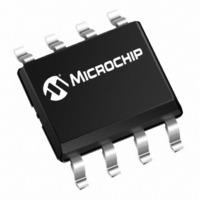24LC256-E/MS Microchip Technology, 24LC256-E/MS Datasheet - Page 8

24LC256-E/MS
Manufacturer Part Number
24LC256-E/MS
Description
IC EEPROM 256KBIT 400KHZ 8MSOP
Manufacturer
Microchip Technology
Datasheet
1.24AA256-ISM.pdf
(34 pages)
Specifications of 24LC256-E/MS
Format - Memory
EEPROMs - Serial
Memory Type
EEPROM
Memory Size
256K (32K x 8)
Speed
400kHz
Interface
I²C, 2-Wire Serial
Voltage - Supply
2.5 V ~ 5.5 V
Operating Temperature
-40°C ~ 125°C
Package / Case
8-MSOP, Micro8™, 8-uMAX, 8-uSOP,
Lead Free Status / RoHS Status
Lead free / RoHS Compliant
Available stocks
Company
Part Number
Manufacturer
Quantity
Price
Company:
Part Number:
24LC256-E/MS
Manufacturer:
MCP
Quantity:
100
Part Number:
24LC256-E/MS
Manufacturer:
MICROCHIP/微芯
Quantity:
20 000
24AA256/24LC256/24FC256
5.0
A control byte is the first byte received following the
Start condition from the master device (Figure 5-1).
The control byte consists of a 4-bit control code. For the
24XX256, this is set as ‘
write operations. The next three bits of the control byte
are the Chip Select bits (A2, A1, A0). The Chip Select
bits allow the use of up to eight 24XX256 devices on
the same bus and are used to select which device is
accessed. The Chip Select bits in the control byte must
correspond to the logic levels on the corresponding A2,
A1 and A0 pins for the device to respond. These bits
are, in effect, the three Most Significant bits of the word
address.
For the MSOP package, the A0 and A1 pins are not
connected. During device addressing, the A0 and A1
Chip Select bits (Figures 5-1 and 5-2) should be set to
‘0’. Only two 24XX256 MSOP packages can be
connected to the same bus.
The last bit of the control byte defines the operation to
be performed. When set to a one, a read operation is
selected. When set to a zero, a write operation is
selected. The next two bytes received define the
address of the first data byte (Figure 5-2). Because
only A14…A0 are used, the upper address bits are a
“don’t care.” The upper address bits are transferred
first, followed by the Less Significant bits.
Following the Start condition, the 24XX256 monitors
the SDA bus checking the device type identifier being
transmitted. Upon receiving a ‘
appropriate device select bits, the slave device outputs
an Acknowledge signal on the SDA line. Depending on
the state of the R/W bit, the 24XX256 will select a read
or write operation.
FIGURE 5-2:
DS21203Q-page 8
1
Control
Code
DEVICE ADDRESSING
0
1
Control Byte
0
A
2
ADDRESS SEQUENCE BIT ASSIGNMENTS
Select
Chip
Bits
A
1
1010’
A
0 R/W
binary for read and
1010’
x
code and
14
A
Address High Byte
13
A
12
A
11
A
10
A
FIGURE 5-1:
5.1
The Chip Select bits A2, A1 and A0 can be used to
expand the contiguous address space for up to 2 Mbit
by adding up to eight 24XX256 devices on the same
bus. In this case, software can use A0 of the control
byte as address bit A15; A1 as address bit A16; and A2
as address bit A17. It is not possible to sequentially
read across device boundaries.
For the MSOP package, up to two 24XX256 devices
can be added for up to 512 Kbit of address space. In
this case, software can use A2 of the control byte as
address bit A17. Bits A0 (A15) and A1 (A16) of the
control byte must always be set to a logic ‘0’ for the
MSOP.
Start Bit
A
9
S
A
8
Contiguous Addressing Across
Multiple Devices
1
Control Code
0
A
7
Slave Address
1
•
CONTROL BYTE
FORMAT
Address Low Byte
2010 Microchip Technology Inc.
0
•
•
Chip Select
A2
Read/Write Bit
Acknowledge Bit
•
Bits
A1
x = “don’t care” bit
•
A0
•
R/W
A
0
ACK















